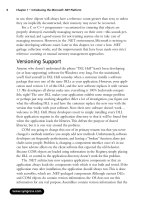C# .NET Web Developer''''s Guide phần 10 pptx
Bạn đang xem bản rút gọn của tài liệu. Xem và tải ngay bản đầy đủ của tài liệu tại đây (436.5 KB, 79 trang )
716 Chapter 12 • Building a Jokes Web Services
/// moderators in the database.
/// </summary>
/// <remarks>
/// Author: Adrian Turtschi; ; Sept 2001
/// </remarks>
[WebServiceAttribute(Description="The userAdmin web service " +
"provides methods to manage users and moderators in the database",
Namespace="urn:schemas-syngress-com-soap")]
public class userAdmin : System.Web.Services.WebService {
// SOAP error handling return document structure
/// <value>error document thrown by SOAP exception</value>
public XmlDocument soapErrorDoc;
/// <value>text node with user-friendly error message</value>
public XmlNode xmlFailReasonNode;
/// <summary>
/// Public class constructor.
/// </summary>
public userAdmin() {
InitializeComponent();
// initialize SOAP error handling return document
soapErrorDoc = new System.Xml.XmlDocument();
xmlFailReasonNode =
soapErrorDoc.CreateNode(XmlNodeType.Element, "failReason", "");
}
}
}
The code for the addUser() method that adds a new user to the database is
shown in Figure 12.22.
www.syngress.com
Figure 12.21 Continued
Building a Jokes Web Services • Chapter 12 717
Figure 12.22 addUser Web Method (userAdmin.asmx.cs)
01: /// <summary>
02: /// The addUser method adds a new user to the database
03: /// </summary>
04: /// <param name='userName'
05: /// type='string'
06: /// desc='name of new user'>
07: /// </param>
08: /// <param name='password'
09: /// type='string'
10: /// desc='password of new user'>
11: /// </param>
12: /// <returns>nothing</returns>
13: [SoapDocumentMethodAttribute(Action="addUser",
14: RequestNamespace="urn:schemas-syngress-com-soap:userAdmin",
15: RequestElementName="addUser",
16: ResponseNamespace="urn:schemas-syngress-com-soap:userAdmin",
17: ResponseElementName="addUserResponse")]
18: [WebMethod(Description="The addUser method adds a new user to " +
19: "the database")]
20: public void addUser(string userName, string password) {
21: userAdminImplement userAdminObj = new userAdminImplement();
22: try {
23: userAdminObj.addUser(userName, password);
24: // catch jokeExceptions
25: } catch (jokeException e) {
26: throwFault("Fault occurred", e.failReason, userName);
27: }
28: // then, catch general System Exceptions
29: catch (Exception e) {
30 throwFault(e.Message, "F_System", userName);
31: }
32: }
www.syngress.com
718 Chapter 12 • Building a Jokes Web Services
Note how simple things suddenly become once you have set the stage cor-
rectly:You need just two lines to add a new user to the system. Note two things
in Figure 12.22:
■
First, some decorations were added to the Web method (which
Microsoft calls metadata).They specify the namespaces (lines 14 and 16)
and element names (lines 15 and 17) used by the SOAP protocol, as
described in Chapter 11.
■
Second, if an exception occurs, you call a custom error handler that
returns extended error information as part of a SOAP fault (lines 25
and 26).
Error Handling for the Public Web Methods
If you look at the code that adds users to the system, you’ll see that throwFault
(Figure 12.22, lines 26 and 30) is the name of the method that actually throws a
SOAP fault and ends execution of the Web Service method. But it does a whole
lot more:
■
The (internal) error code is replaced by a user-friendly error message.
■
A log entry is written to the Application event log.
■
The standard SOAP fault XML document is appended with a custom
element, called failReason, where client applications can find the error
message to display to users.
The details of the throwFault method are shown in Figure 12.23.
Figure 12.23
throwFault Method (userAdmin.asmx.cs)
/// <summary>
/// The throwFault method throws a SOAP fault and ends
/// execution of the Web Service method
/// </summary>
/// <param name='message'
/// type='string'
/// desc='start of text node of faultstring element in
/// SOAP fault message'>
/// </param>
/// <param name='failReason'
www.syngress.com
Continued
Building a Jokes Web Services • Chapter 12 719
/// type='string'
/// desc='text node for custom failReason element in SOAP
/// fault message'>
/// </param>
/// <param name='userName'
/// type='string'
/// desc='name of registered user'>
/// </param>
/// <returns>nothing</returns>
private void throwFault(string message, string failReason, string
userName) {
xmlFailReasonNode.AppendChild(soapErrorDoc.CreateTextNode(
jokeException.getNiceErrorMessage(failReason)));
jokeException.writeEventLogEntry(userName, failReason);
throw new SoapException(message, SoapException.ServerFaultCode,
Context.Request.Url.AbsoluteUri,null,
new System.Xml.XmlNode[]{xmlFailReasonNode});
}
For instance, if you try to add a user who is already registered, a SOAP fault
will be returned, as pictured in Figure 12.24.
www.syngress.com
Figure 12.23 Continued
Figure 12.24 A SOAP Fault Extended by a Custom XML Element
720 Chapter 12 • Building a Jokes Web Services
Creating the Public Web Methods—Administrators
The two other public Web methods of the userAdmin Web Service are very sim-
ilar in their structure to the addUser Web method; they are the Web method
addModerator(), which adds a new moderator to the database, and the Web method
checkUser(), which checks if a user or moderator is already defined in the database.
Those two methods are presented in Figures 12.25 and 12.26, respectively.
Figure 12.25
addModerator Web Method (userAdmin.asmx.cs)
/// <summary>
/// The addModerator method adds a new moderator to the database
/// </summary>
/// <param name='userName'
/// type='string'
/// desc='name of moderator'>
/// </param>
/// <param name='password'
/// type='string'
/// desc='password of moderator'>
/// </param>
/// <param name='newModerator'
/// type='string'
/// desc='user name of user who will become a moderator'>
/// </param>
/// <returns>nothing</returns>
[SoapDocumentMethodAttribute(Action="addModerator",
RequestNamespace="urn:schemas-syngress-com-soap:userAdmin",
RequestElementName="addModerator",
ResponseNamespace="urn:schemas-syngress-com-soap:userAdmin",
ResponseElementName="addModeratorResponse")]
[WebMethod(Description="The addModerator method adds a new " +
"moderator to the database")]
public void addModerator(
string userName, string password, string newModerator) {
userAdminImplement userAdminObj = new userAdminImplement();
try {
www.syngress.com
Continued
Building a Jokes Web Services • Chapter 12 721
userAdminObj.addModerator(userName, password, newModerator);
// catch jokeExceptions
} catch (jokeException e) {
throwFault("Fault occurred", e.failReason, userName);
}
// then, catch general System Exceptions
catch (Exception e) {
throwFault(e.Message, "F_System", userName);
}
}
Figure 12.26 checkUser Web Method (userAdmin.asmx.cs)
/// <summary>
/// The checkUser method checks if a user or moderator is
/// already defined in the database
/// </summary>
/// <param name='userName'
/// type='string'
/// desc='name of user or moderator'>
/// </param>
/// <param name='password'
/// type='string'
/// desc='password of user or moderator'>
/// </param>
/// <param name='isModerator'
/// type='bool'
/// desc='check for moderator status (if false, we do
/// not check)'>
/// </param>
/// <returns>nothing</returns>
[SoapDocumentMethodAttribute(Action="checkUser",
RequestNamespace="urn:schemas-syngress-com-soap:userAdmin",
www.syngress.com
Figure 12.25 Continued
Continued
722 Chapter 12 • Building a Jokes Web Services
RequestElementName="checkUser",
ResponseNamespace="urn:schemas-syngress-com-soap:userAdmin",
ResponseElementName="checkUserResponse")]
[WebMethod(Description="The checkUser method checks if a user " +
"or moderator is already defined in the database")]
public void checkUser(
string userName, string password, bool isModerator) {
userAdminImplement userAdminObj = new userAdminImplement();
try {
userAdminObj.checkUser(userName, password, isModerator);
// catch jokeExceptions
} catch (jokeException e) {
throwFault("Fault occurred", e.failReason, userName);
}
// then, catch general System Exceptions
catch (Exception e) {
throwFault(e.Message, "F_System", userName);
}
}
Et voilà! You’re done with your first “real”Web Service: the userAdmin We b
Service, which is the user administration module for the Jokes application.
Testing the Public Web Methods
You can immediately check if things work properly by calling it from a Visual
Basic script, as described in Chapter 11.The VBS script shown in Figure 12.27
will add a new user.
Figure 12.27
A Simple Visual Basic Script to Test Adding a New User to the
Database
myWebService = "http://localhost/Jokes1/userAdmin.asmx"
myMethod = "addUser"
'** create the SOAP envelope with the request
www.syngress.com
Figure 12.26 Continued
Continued
Building a Jokes Web Services • Chapter 12 723
myData = ""
myData = myData & "<?xml version=""1.0"" encoding=""utf-8""?>"
myData = myData & "<soap:Envelope xmlns:soap=""http://schemas."
myData = myData & "xmlsoap.org/soap/envelope/"">"
myData = myData & " <soap:Body>"
myData = myData & " <addUser xmlns=""urn:schemas-syngress-"
myData = myData & "com-soap:userAdmin"">"
myData = myData & " <userName>newUser</userName>"
myData = myData & " <password>newPassword</password>"
myData = myData & " </addUser>"
myData = myData & " </soap:Body>"
myData = myData & "</soap:Envelope>"
msgbox(myData)
set requestHTTP = CreateObject("Microsoft.XMLHTTP")
msgbox("xmlhttp object created")
requestHTTP.open "POST", myWebService, false
requestHTTP.setrequestheader "Content-Type", "text/xml"
requestHTTP.setrequestheader "SOAPAction", myMethod
requestHTTP.Send myData
msgbox("request sent")
set responseDocument = requestHTTP.responseXML
msgbox(requestHTTP.status)
msgbox(responseDocument.xml)
If things go right, a new user should be added to the database, and a message
box depicting a SOAP return envelope should appear, as shown in Figure 12.28.
www.syngress.com
Figure 12.27 Continued
724 Chapter 12 • Building a Jokes Web Services
Developing the Jokes Service
The second Web Service to develop is the jokes Web Service.The main feature of
this Web Service is that it lets registered users retrieve jokes.Additionally, it con-
tains methods to administer jokes, such as adding and removing jokes, approving
jokes submitted by users to be visible to other users, and giving users a way to
rate existing jokes. In many respects, things are set up in parallel from what you
have already seen in the userAdmin Web Service, which is the Web Service to
manage user information.
Best Practices for Returning Highly Structured Data
Compared with the userAdmin Web Service you have just developed, the jokes
Web Service has one key additional difficulty: how to return joke data.The
requirements are as follows:
■
Return anywhere from 1 to 10 jokes.
■
Along with each joke, return its average user rating and the joke identi-
fier (for future reference, if for example a user wants to rate that joke).
From the stored procedure sp_getJokes, you can get a SQL record set. One
possibility, then, is to simply return the jokes as “record sets” (the correct term
here is objects of type System.Data.DataSet).This magic works because the .NET
SOAP serializer, which is the piece of code that puts the data in XML format to
be sent back inside a SOAP return envelope, can indeed serialize that kind of
data out of the box. However, as we discussed in Chapter 11, returning serialized
DataSets may often not be a good idea because in practice it pretty much forces
your clients to run on a Microsoft .NET platform, counter to the idea of Web
Services to be an open standard.
www.syngress.com
Figure 12.28 A Successful Call to Add a New Registered User
Building a Jokes Web Services • Chapter 12 725
What alternatives do you have? Again, our advice is to use a simple structure
adapted to the problem at hand. If you want your clients to validate the XML
against a DTD or an XML Schema, you can always pass that information as a
URL (maybe to another Web Service!), but don’t pass that information by default
with every call to the client. In your case, you simply pass a structure that looks
essentially like everything above starting from the NewDataSet element; that is,
you want an XML element delineating rows of data, and additional XML ele-
ments delineating the fields of data within each row of data.
This is done very simply by creating a custom C# class, the xmlJokesReturn
class, which is designed to hold a single row of data, as shown in Figure 12.29. Of
course, if you prefer, you could achieve the same thing by using a structure.
Figure 12.29
The xmlJokesReturn Class That Holds the Jokes
(xmlJokesReturn.cs)
using System;
namespace jokesService
{
/// <summary>
/// The xmlJokesReturn class is the return type of all public
/// methods returning joke data.
/// </summary>
/// <remarks>
/// Author: Adrian Turtschi; ; Sept 2001
/// </remarks>
public class xmlJokesReturn {
/// <value>ID of joke returned</value>
public string jokeID;
/// <value>the actual joke</value>
public string joke;
/// <value>average rating of the joke (can be empty)</value>
public string rating;
/// <summary>
/// Public class constructor.
www.syngress.com
Continued
726 Chapter 12 • Building a Jokes Web Services
/// </summary>
public xmlJokesReturn() {
}
}
}
Because you may return more than one row of data, of course, you can
simply set up the getJokes Web method to return an array of objects of type
xmlJokesReturn.The SOAP serializer does the rest automatically. In Figure 12.30,
you can see the definition of the getJokes Web method (note that we haven’t
talked about the corresponding implementation method yet).
Figure 12.30
getJokes Web method (jokes.asmx.cs)
[WebMethod]
public xmlJokesReturn[] getJokes(
string userName, string password, int howMany) {
jokesImplement jokesObj = new jokesImplement();
try {
xmlJokesReturn[] myJokes =
jokesObj.getJokes(userName, password, howMany);
return myJokes;
}
// error handler omitted
The SOAP object serializer does what it is supposed to do, that is it returns a
serialized array of xmlJokesReturn objects, and you retrieve a SOAP envelope on
the client that may look like the one in Figure 12.31, containing two jokes.
Figure 12.31
SOAP Response Envelope Containing Two Jokes as Serialized
xmlJokesReturn Objects
<?xml version="1.0" encoding="utf-8"?>
<soap:Envelope xmlns:soap=" />xmlns:xsi=" />xmlns:xsd=" />www.syngress.com
Figure 12.29 Continued
Continued
Building a Jokes Web Services • Chapter 12 727
<soap:Body>
<getJokesResponse xmlns="urn:schemas-syngress-com-soap:jokes">
<jokeData>
<jokeID>1</jokeID>
<joke>this is the first joke</joke>
<rating>3.5</rating>
</jokeData>
<jokeData>
<jokeID>2</jokeID>
<joke>this is the second joke</joke>
<rating />
</jokeData>
</getJokesResponse>
</soap:Body>
</soap:Envelope>
Setting Up Internal Methods to
Wrap the Stored Procedure Calls
Similar to the way you proceeded when developing the userAdmin We b
Service, you want to create internal methods to wrap calls to the stored proce-
dures that interface with the jokes in the database.You have three stored proce-
dures that deal with jokes:
■
sp_manageJoke
■
sp_manageRating
■
sp_returnJokes
The corresponding wrapping methods, part of file JokesImplement.cs, are
shown in detail in Figure 12.32 (createSqlManageJoke), Figure 12.33
(createSqlManageRating), and Figure 12.34 (createSqlReturnJokes).
www.syngress.com
Figure 12.31 Continued
728 Chapter 12 • Building a Jokes Web Services
Figure 12.32 createSqlManageJoke Method (JokesImplement.cs)
/// <summary>
/// The createSqlManageJoke method sets up the SQL command object
/// for the stored procedure sp_manageJoke, which deals with
/// adding, updating, and deleting jokes
/// </summary>
/// <param name='userName'
/// type='string'
/// desc='name of registered user (zero length if N/A)'>
/// </param>
/// <param name='joke'
/// type='string'
/// desc='the joke (zero length if N/A)'>
/// </param>
/// <param name='isModerated'
/// type='string'
/// desc='true/false if this is/is not a moderated joke
/// (zero length if N/A)'>
/// </param>
/// <param name='jokeID'
/// type='string'
/// desc='the joke ID for the joke (zero length if N/A)'>
/// </param>
/// <param name='action'
/// type='string'
/// desc='the action the SQL stored procedure should take
/// (see the stored procedure definition for allowed action
/// keywords)'>
/// </param>
/// <param name='sqlCommand'
/// type='SqlCommand'
/// desc='a reference to a SQL command object'>
/// </param>
/// <returns>the prepared SQL command object</returns>
www.syngress.com
Continued
Building a Jokes Web Services • Chapter 12 729
protected internal void createSqlManageJoke(
string userName, string joke, string isModerated,
string jokeID, string action, SqlCommand sqlCommand) {
sqlCommand.CommandType = CommandType.StoredProcedure;
sqlCommand.CommandText = "sp_manageJoke" ;
SqlParameter argUserName =
new SqlParameter("@@userName", SqlDbType.NVarChar, 20);
if(userName.Length > 0) {
argUserName.Value = userName;
} else {
argUserName.Value = DBNull.Value;
}
sqlCommand.Parameters.Add(argUserName);
SqlParameter argJoke =
new SqlParameter("@@joke",SqlDbType.NVarChar, 3500);
if(joke.Length > 0) {
argJoke.Value = joke;
} else {
argJoke.Value = DBNull.Value;
}
sqlCommand.Parameters.Add(argJoke);
SqlParameter argIsModerated =
new SqlParameter("@@isModerated",SqlDbType.Bit);
if(isModerated.Length > 0) {
argIsModerated.Value = bool.Parse(isModerated);
} else {
argIsModerated.Value = DBNull.Value;
}
sqlCommand.Parameters.Add(argIsModerated);
www.syngress.com
Figure 12.32 Continued
Continued
730 Chapter 12 • Building a Jokes Web Services
SqlParameter argJokeID =
new SqlParameter("@@jokeID",SqlDbType.Int);
if(jokeID.Length > 0) {
argJokeID.Value = Int32.Parse(jokeID);
} else {
argJokeID.Value = DBNull.Value;
}
sqlCommand.Parameters.Add(argJokeID);
SqlParameter argAction =
new SqlParameter("@@action",SqlDbType.NVarChar, 20);
argAction.Value = action;
sqlCommand.Parameters.Add(argAction);
SqlParameter argReturn =
new SqlParameter("@@return",SqlDbType.NVarChar, 20,
ParameterDirection.Output, true, 0, 0, "",
DataRowVersion.Current, "");
sqlCommand.Parameters.Add(argReturn);
}
Figure 12.33 createSqlManageRating Method (JokesImplement.cs)
/// <summary>
/// The createSqlManageRating method sets up the SQL command
/// object for the stored procedure sp_manageRating, which
/// deals with adding and deleting user joke ratings
/// </summary>
/// <param name='jokeID'
/// type='string'
/// desc='the joke ID for the joke we would like to rate'>
/// </param>
www.syngress.com
Figure 12.32 Continued
Continued
Building a Jokes Web Services • Chapter 12 731
/// <param name='rating'
/// type='string'
/// desc='the user rating for the joke (1-5)'>
/// </param>
/// <param name='action'
/// type='string'
/// desc='the action the SQL stored procedure should take
/// (see the stored procedure definition for allowed action
/// keywords)'>
/// </param>
/// <param name='sqlCommand'
/// type='SqlCommand'
/// desc='a reference to a SQL command object'>
/// </param>
/// <returns>the prepared SQL command object</returns>
protected internal void createSqlManageRating(
string jokeID, string rating, string action,
SqlCommand sqlCommand) {
sqlCommand.CommandType = CommandType.StoredProcedure;
sqlCommand.CommandText = "sp_manageRating" ;
SqlParameter argJokeID =
new SqlParameter("@@jokeID", SqlDbType.Int);
argJokeID.Value = Int32.Parse(jokeID);
sqlCommand.Parameters.Add(argJokeID);
SqlParameter argRating =
new SqlParameter("@@rating",SqlDbType.TinyInt);
argRating.Value = Int32.Parse(rating);
sqlCommand.Parameters.Add(argRating);
SqlParameter argAction =
www.syngress.com
Figure 12.33 Continued
Continued
732 Chapter 12 • Building a Jokes Web Services
new SqlParameter("@@action",SqlDbType.NVarChar, 20);
argAction.Value = action;
sqlCommand.Parameters.Add(argAction);
SqlParameter argReturn =
new SqlParameter("@@return",SqlDbType.NVarChar, 20,
ParameterDirection.Output, true, 0, 0, "",
DataRowVersion.Current, "");
sqlCommand.Parameters.Add(argReturn);
}
Figure 12.34 createSqlReturnJokes Method (JokesImplement.cs)
/// <summary>
/// The createSqlReturnJokes method sets up the SQL command object
/// for the stored procedure sp_returnJokes, which returns jokes
/// </summary>
/// <param name='howMany'
/// type='string'
/// desc='how many jokes we would like (zero length if N/A)'>
/// </param>
/// <param name='isModerated'
/// type='string'
/// desc='true/false if we are interested in (not) moderated
/// jokes (zero length if N/A)'>
/// </param>
/// <param name='returnRandom'
/// type='string'
/// desc='true/false if we are interested getting random jokes
/// (actually, only the starting position is random, from there
/// on we retrieve jokes in sequential order for practical
/// reasons)'>
/// </param>
www.syngress.com
Figure 12.33 Continued
Continued
Building a Jokes Web Services • Chapter 12 733
/// <param name='sqlCommand'
/// type='SqlCommand'
/// desc='a reference to a SQL command object'>
/// </param>
/// <returns>the prepared SQL command object</returns>
protected internal void createSqlReturnJokes(
string howMany, string isModerated, string returnRandom,
SqlCommand sqlCommand) {
sqlCommand.CommandType = CommandType.StoredProcedure;
sqlCommand.CommandText = "sp_returnJokes" ;
SqlParameter argHowMany =
new SqlParameter("@@howMany", SqlDbType.Int);
if(howMany.Length > 0) {
argHowMany.Value = Int32.Parse(howMany);
} else {
argHowMany.Value = DBNull.Value;
}
sqlCommand.Parameters.Add(argHowMany);
SqlParameter argIsModerated =
new SqlParameter("@@isModerated",SqlDbType.Bit);
if(isModerated.Length > 0) {
argIsModerated.Value = bool.Parse(isModerated);
} else {
argIsModerated.Value = DBNull.Value;
}
sqlCommand.Parameters.Add(argIsModerated);
SqlParameter argReturnRandom =
new SqlParameter("@@returnRandom",SqlDbType.Bit);
argReturnRandom.Value = bool.Parse(returnRandom);
www.syngress.com
Figure 12.34 Continued
Continued
734 Chapter 12 • Building a Jokes Web Services
sqlCommand.Parameters.Add(argReturnRandom);
}
Setting Up Internal Methods
to Manage Jokes and Ratings
Now that you can call the stored procedures that deal with jokes in the database,
you want to implement the business logic that deals with jokes.You have four
methods that either add or delete jokes and ratings:
■
addJoke() Checks that user is registered, and then adds the passed joke
as an unmoderated joke to the system.
■
addRating() Checks that user is registered, and then adds the passed
rating to the joke having the passed joke identifier to the system.
■
addModerated() Checks that user is a moderator, and then changes
the isModerated flag of the joke having the passed joke identifier to
the system.
■
deleteUnmoderated() Checks that user is a moderator, and then
removes the joke having the passed joke identifier, along with all its user
ratings, from the system.
Figure 12.35 shows the business logic for the addJoke method, and
Figures12.36, 12.37, and 12.38 deal with the addRating, addModerated, and
deleteUnmoderated methods, respectively.
Figure 12.35
addJoke Method (JokesImplement.cs)
/// <summary>
/// The addJoke method lets registered users add a joke
/// </summary>
/// <param name='userName'
/// type='string'
/// desc='name of registered user'>
/// </param>
/// <param name='password'
www.syngress.com
Figure 12.34 Continued
Continued
Building a Jokes Web Services • Chapter 12 735
/// type='string'
/// desc='password of registered user'>
/// </param>
/// <param name='joke'
/// type='string'
/// desc='the joke we are adding'>
/// </param>
/// <returns>true</returns>
protected internal bool addJoke(
string userName, string password, string joke) {
string retCode;
try {
// check if user is registered
userAdminImplement myUser = new userAdminImplement();
SqlCommand sqlCommand = new SqlCommand();
myUser.createSqlCheckUser(userName, password, "", sqlCommand);
databaseAccess myDatabase = new databaseAccess();
sqlCommand.Connection = myDatabase.getConnection();
sqlCommand.Connection.Open();
sqlCommand.ExecuteNonQuery();
retCode = sqlCommand.Parameters["@@return"].Value.ToString();
// exit, if user not registered
if (retCode != "S_OK") {
sqlCommand.Connection.Close();
throw new jokeException(retCode);
}
// add the joke (unmoderated, at this point)
www.syngress.com
Figure 12.35 Continued
Continued
736 Chapter 12 • Building a Jokes Web Services
sqlCommand.Parameters.Clear();
createSqlManageJoke(
userName, joke, "false", "", "add", sqlCommand);
sqlCommand.ExecuteNonQuery();
sqlCommand.Connection.Close();
retCode = sqlCommand.Parameters["@@return"].Value.ToString();
// catch problems within the stored procedure
if (retCode == "S_OK") {
return true;
} else {
throw new jokeException(retCode);
}
// catch problems with the database
} catch (Exception e) {
throw e;
}
}
Figure 12.36 addRating Method (JokesImplement.cs)
/// <summary>
/// The addRating method lets registered users rate a joke
/// </summary>
/// <param name='userName'
/// type='string'
/// desc='name of registered user'>
/// </param>
/// <param name='password'
/// type='string'
/// desc='password of registered user'>
www.syngress.com
Figure 12.35 Continued
Continued
Building a Jokes Web Services • Chapter 12 737
/// </param>
/// <param name='rating'
/// type='int'
/// desc='the rating of the joke to rate (1-5)'>
/// </param>
/// <param name='jokeID'
/// type='int'
/// desc='the ID of the joke to rate'>
/// </param>
/// <returns>true</returns>
protected internal bool addRating(
string userName, string password, int rating, int jokeID) {
string retCode;
try {
// check if user is registered
userAdminImplement myUser = new userAdminImplement();
SqlCommand sqlCommand = new SqlCommand();
myUser.createSqlCheckUser(userName, password, "", sqlCommand);
databaseAccess myDatabase = new databaseAccess();
sqlCommand.Connection = myDatabase.getConnection();
sqlCommand.Connection.Open();
sqlCommand.ExecuteNonQuery();
retCode = sqlCommand.Parameters["@@return"].Value.ToString();
// exit, if user not registered
if (retCode != "S_OK") {
sqlCommand.Connection.Close();
throw new jokeException(retCode);
}
www.syngress.com
Figure 12.36 Continued
Continued
738 Chapter 12 • Building a Jokes Web Services
// add the joke rating
sqlCommand.Parameters.Clear();
createSqlManageRating(
jokeID.ToString(), rating.ToString(), "add", sqlCommand);
sqlCommand.ExecuteNonQuery();
sqlCommand.Connection.Close();
retCode = sqlCommand.Parameters["@@return"].Value.ToString();
// catch problems within the stored procedure
if (retCode == "S_OK") {
return true;
} else {
throw new jokeException(retCode);
}
// catch problems with the database
} catch (Exception e) {
throw e;
}
}
Figure 12.37 addModerated Method (JokesImplement.cs)
/// <summary>
/// The addModerated method sets a previously submitted joke
/// to become a moderated joke
/// (for moderators only)
/// </summary>
/// <param name='userName'
/// type='string'
/// desc='name of moderator'>
www.syngress.com
Figure 12.36 Continued
Continued
Building a Jokes Web Services • Chapter 12 739
/// </param>
/// <param name='password'
/// type='string'
/// desc='password of moderator'>
/// </param>
/// <param name='jokeID'
/// type='int'
/// desc='joke ID of joke'>
/// </param>
/// <returns>an XML representation (xmlJokesReturn)
/// of a single joke</returns>
protected internal bool addModerated(
string userName, string password, int jokeID) {
string retCode;
try {
// check if user is a moderator
userAdminImplement myUser = new userAdminImplement();
SqlCommand sqlCommand = new SqlCommand();
myUser.createSqlCheckUser(
userName, password, "true", sqlCommand);
databaseAccess myDatabase = new databaseAccess();
sqlCommand.Connection = myDatabase.getConnection();
sqlCommand.Connection.Open();
sqlCommand.ExecuteNonQuery();
retCode = sqlCommand.Parameters["@@return"].Value.ToString();
// exit, if user not a moderator
if (retCode != "S_OK") {
sqlCommand.Connection.Close();
www.syngress.com
Figure 12.37 Continued
Continued
740 Chapter 12 • Building a Jokes Web Services
throw new jokeException(retCode);
}
// make the joke a moderated one
sqlCommand.Parameters.Clear();
createSqlManageJoke(userName, "", "true", jokeID.ToString(),
"modify", sqlCommand);
sqlCommand.ExecuteNonQuery();
sqlCommand.Connection.Close();
retCode = sqlCommand.Parameters["@@return"].Value.ToString();
// catch problems within the stored procedure
if (retCode == "S_OK") {
return true;
} else {
throw new jokeException(retCode);
}
// catch problems with the database
} catch (Exception e) {
throw e;
}
}
Figure 12.38 deleteUnmoderated Method (JokesImplement.cs)
/// <summary>
/// The deleteUnmoderated method deletes a previously
/// submitted joke (unmoderated) joke
/// (for moderators only)
/// </summary>
/// <param name='userName'
www.syngress.com
Figure 12.37 Continued
Continued









